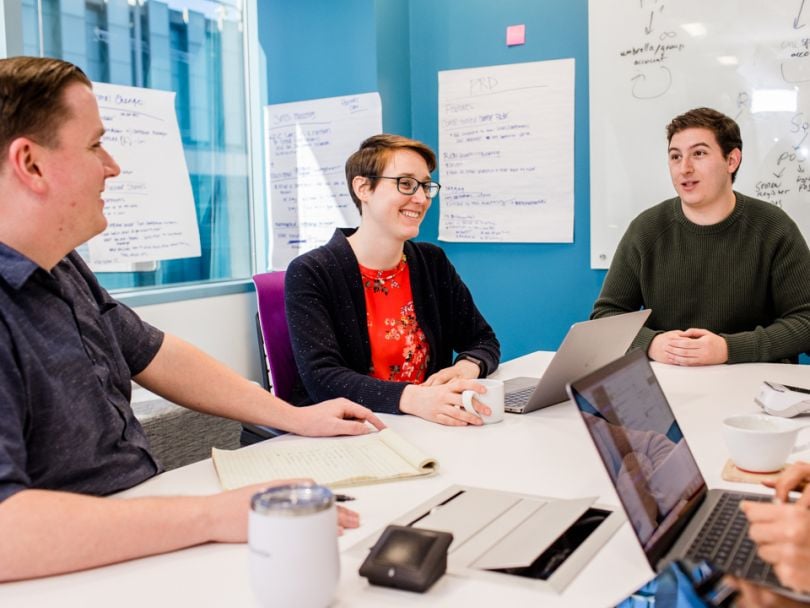In SpotOn’s Chicago office on West Madison — nestled between the central hub of Chicago’s downtown and its ever-trendy counterpart, the West Loop — Project Manager Briana Shucart sits in a conference room and meets with her fellow teammates, one of the many times throughout the week she’ll do so.
Shucart is joined by her co-workers on some days, but today, Shucart sits alone as her teammates wave, laugh and chat through the conference room’s TV. They represent a group of the company’s employees spread around the world in SpotOn’s additional offices in Detroit, and San Francisco, Mexico City and Krakow, Poland.
Although many members of the SpotOn team do sit in the product headquarters in Chicago — and Shucart meets with them quite often, too — her remote crew faces an increasingly common setup of virtual communication. In order to collaborate well, even in person, Shucart and co. know it takes more than a few simple check-ins.
On a day-to-day basis, Shucart gathers requirements for new projects, works with product owners to plan SpotOn’s roadmap and fosters healthy communication — between development teams internally and with stakeholders who sit externally, too.
“It would be really easy for each of these teams to be siloed, but everyone at SpotOn takes the time to get to know their team members,” Shucart said. “Some of my team members have become my close friends.”
In today’s hustle and bustle culture, seeing relationships like these blossom takes a concentrated effort. Even simple concepts like collaboration are harder to prioritize as we become inundated with work.

Yet, the importance of collaboration isn’t lost. According to a 2019 survey from Slack, the company identified collaboration — not innovation, not work-life balance — as the foundation for success in its workplace, because it creates the ability for employees to branch out and be autonomous, empowering employees to get the work they want to get done, done.
If collaboration is the yin, Slack concluded, autonomy is the yang.
“There is a ‘circular relationship’ between collaboration and autonomy,” the report said. “Collaboration with colleagues leads to more autonomous work being created, and autonomous initiatives often lead to meaningful work with colleagues.”
Working effectively together allows us to work effectively alone. That may seem straightforward, but in practice, it’s a little more complicated. Shucart and the team at SpotOn, though, have laid the groundwork for successful and transparent collaboration — and it’s up to everyone to keep it going.

The Building Blocks of Collaboration
As the bird’s-eye view of the development teams at SpotOn, Shucart can see when communication flows smoothly — and, more importantly, when it doesn’t. In order to avoid the latter, Shucart runs point on collaboration for software development, from gathering requirements for projects to fostering conversations with team members and clients.
“Creating software is inherently collaborative,” Shucart said. “Sure, you could go off and build an app on your own, but you’d miss factors important to the experience of many of your users. I can’t tell you how many times I’ve been in a meeting when we are talking through requirements, reviewing a design, or even ticketing out the technical aspect of a project and someone says, ‘Hey, what about X?’”
Having multiple perspectives, Shucart said, allows for pain point discovery earlier in the process. At SpotOn, Shucart said employees feel like they can speak up, whether that’s about a product update or how to improve development processes.
Recently, Shucart’s team was working through a labor enforcement integration for its restaurant product. Through this addition, managers would be notified when employees clock in too early for shifts. But as one engineer on the project pointed out, it’s common for employees in the restaurant industry to hold several positions. How would the integration account for that?
The solution: A simple gray-out of the employee’s positions, information that was already integrated using scheduling data from a partner company.
“This was a great suggestion that made the login process easier for the employee by not making them guess which position they should be clocking in with,” Shucart said. “Speaking up early prevented us from having to do another iteration to add that feature in the future.”

Shucart said the ability to pitch ideas freely comes from SpotOn’s flat organization, where there’s less red tape than structured hierarchies and more emphasis on good ideas than on titles.
“It’s about collaboration, not ego,” Shucart said. “Sometimes I go to our co-founder, Doron Friedman, for advice when I’m having trouble moving a project forward, and sometimes I’m the one suggesting an alternate design for our product or priority for our immediate roadmap. Ultimately, I don’t have to go through hoops to get answers.”
In addition to mentoring his team and setting the technical vision, Siegman manages priorities and incoming requests — all while getting his hands dirty with SpotOn’s technology.
Shucart’s colleague, DevOps Team Lead Alex Siegman, agreed. At its essence, his role in the organization is to crowdsource the best ideas.
“SpotOn relies heavily on its technical team leads, who in turn rely on the expertise of their teams to help drive technical decisions, rather than a top-down decision-making approach,” Siegman said. “It’s refreshing to see teams sharing ideas and knowledge on a regular basis to come to sustainable and maintainable ways to solve business and technical challenges.”
QA Engineer Minever Abdurahmanova, whose team is responsible for testing SpotOn’s products and signing off on releases, said a general sense of meritocracy allows her to do her work more efficiently.
“Our culture is the true sense of collaboration, as we don't have a technical hierarchy, and this means everyone is given a sense of responsibility and trust,” Abdurahmanova said. “Being able to own the product testing and work with the developers directly gives me the flexibility to bring the product to the next stage efficiently.”
Abdurahmanova’s team is in charge of testing every product in every stage, ensuring that everything produced in Chicago is “100 percent perfect” before it gets into SpotOn users’ hands.
The flat organization’s emphasis on collaboration has created a dialogue between all teams at SpotOn.
Case in point: Siegman collaborates on a consistent basis with Lead Developer Jim Battin, a seven-year veteran at SpotOn. Battin will often sketch proposed software architectures and, while he has extensive knowledge in the kinds of software best equipped to do the job right, he relies on Siegman’s team to make sure the proposed architecture is deployable and maintainable.
Being able to own the product testing and work with the developers directly gives me the flexibility to bring the product to the next stage efficiently.”
“Just this week, Jim came to me with a new design pattern for a high-throughput data ingestion service,” Siegman said. “We debated some pros and cons of the various architectural decisions together, myself from an infrastructure perspective and him from a software architecture perspective.”
Having this kind of dialogue in shaping product isn’t limited to team leads and tenured teammates. According to Shucart, even newer employees bring something to the table.
“We onboarded four developers in June and happened to have a few ticketing and estimation meetings during their first week,” Shucart said. “Despite being new, they all came prepared with ideas on how to tackle those projects.”

With Great Collaboration Comes Great Autonomy
It seems paradoxical, but it holds true: More collaboration upfront means more autonomy downstream. With the collaborative framework that SpotOn has built, the team said employees aren’t seeking approvals every step of the way.
“Self-starters are highly valued at SpotOn, and being able to notice a problem, bring it up, find a solution, prioritize it and eventually fix it is all in the hands of each contributor,” Siegman said. “This allows me and my team to balance the business needs with the perceived right way of doing things and come to solutions that solve both the need and move us along the path to our desired state.”
When he arrived at SpotOn, for example, Siegman noticed that the parts of the organization were running services with multiple operational models. The lack of standardization was preventing the team from a more consistent development and operational experience across the organization.
The solution, Siegman concluded with other team members, was a Kubernetes-based microservices architecture.

The first team to work within the new Kubernetes and containers was SpotOn’s California-based operations development team, and the results of the new environment were made clear in the first run-through.
“After working through the first service with the DevOps team, and a few code reviews to double-check their work, the team produced two more services without waiting on my team for infrastructure support and scheduling infrastructure work,” Siegman said. “This allowed the team to meet the needs of the business and provide value sooner and faster.”
Any company can give you access to hundreds of tools, but here at SpotOn, the team is the tool belt.”
According to Siegman, that safety net — if you need help, someone will be there to help; if you don’t, go off and build — extends to all parts of the SpotOn organization.
“I don’t come from a technical background and sometimes need to ask for clarification on technical specifications,” Shucart says. “No one is ever begrudging, and they always make sure to clarify before we move on. For most of our challenges, Doron will quickly suggest that we reach out to another team or developer to get their insight on the issue.”
According to Abdurahmanova, since every member of the SpotOn team is an expert in their own right, they’re able to give insights on projects that others may not be actively considering.
“Our team is open-minded and gives everyone the chance to use their creativity,” Abdurahmanova says. “Any company can give you access to hundreds of tools, but here at SpotOn, the team is the tool belt.”




